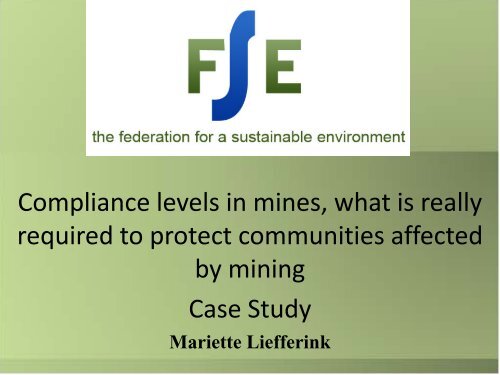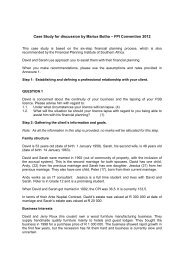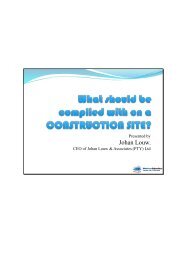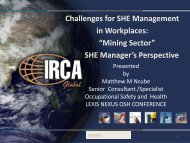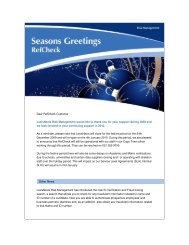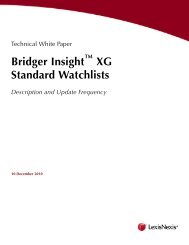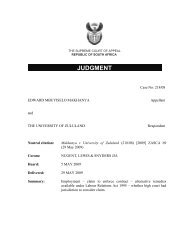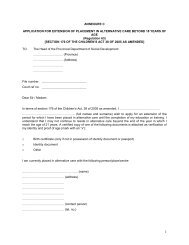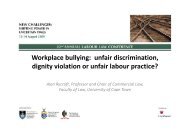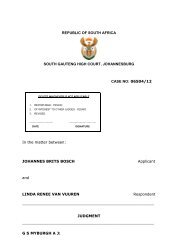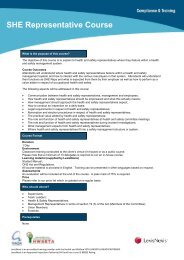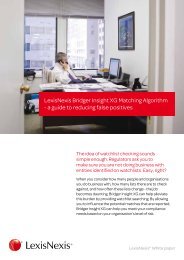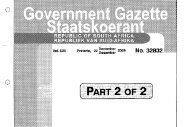Mariette Liefferink OHS Presentation - LexisNexis South Africa
Mariette Liefferink OHS Presentation - LexisNexis South Africa
Mariette Liefferink OHS Presentation - LexisNexis South Africa
You also want an ePaper? Increase the reach of your titles
YUMPU automatically turns print PDFs into web optimized ePapers that Google loves.
Compliance levels in mines, what is really<br />
required to protect communities affected<br />
by mining<br />
Case Study<br />
<strong>Mariette</strong> <strong>Liefferink</strong>
Applicable Environmental Legislative<br />
Matrix<br />
• Common Law<br />
• Promulgated Acts Of Parliament (Constitution)<br />
• Legal Precedents
COMMON LAW<br />
DUTY OF CARE<br />
Duty of care<br />
Determination of amount of care<br />
– Likelihood of injury being caused<br />
– Class of person likely to suffer<br />
– Seriousness of injury risk – gravity of consequences<br />
– Intrinsically harmless contaminants as opposed to intrinsically dangerous<br />
contaminants<br />
– Standard of care required is that of a reasonable person in the circumstances;<br />
there being a higher standard required of persons possessing special skills or<br />
expertise
NATIONAL WATER ACT<br />
Secondly, s 19 of the NWA obliges any person (i.e. not only those who<br />
hold a water use authorization) who has occupied or used land on<br />
which any activity or process was performed that caused (or is likely<br />
to cause) pollution of a water resource, to take all reasonable<br />
measures to prevent such pollution from occurring, continuing or<br />
recurring. Where a person fails to take such measures, the relevant<br />
catchment management agency may direct that specified reasonable<br />
measures be taken.<br />
Where a person fails to comply with such a directive, the catchment<br />
management agency can carry out such reasonable measures as are<br />
required and recover the costs from the person responsible.
NATIONAL ENVIRONMENTAL MANAGEMENT ACT<br />
Section 28 of NEMA establishes a similar but at the same time more<br />
general obligation on every person who has or may cause significant<br />
pollution or degradation of the environment to take reasonable<br />
measures to prevent such pollution or degradation from occurring,<br />
continuing or recurring. Where the pollution or degradation is<br />
authorized by law or cannot reasonably be avoided or stopped a<br />
person must take reasonable measures to minimize and rectify the<br />
pollution or degradation.<br />
The Director-General of the national department responsible for<br />
environmental affairs or a provincial head of department can direct a<br />
person to take reasonable measures and, where they fail to comply,<br />
can cause the measures to be carried out and recover costs from the<br />
responsible person.
MINERAL AND PETROLEUM RESOURCES DEVELOPMENT ACT<br />
Firstly, in terms of the MPRDA, the holder of a prospecting or mining<br />
right is responsible for any environmental damage, pollution or<br />
ecological degradation arising from the prospecting or mining<br />
operations and occurring inside and outside the area to which the right<br />
relates. Liability for environmental damage, pollution or degradation<br />
continues until such time as a closure certificate is issued by the<br />
Minister of Mineral Resources.<br />
Further, directors of a company or members of a close corporation are<br />
jointly and severally liable for any unacceptable impact on the<br />
environment irrespective of whether such damage was done<br />
intentionally or through negligence.
Mine Health and Safety Act<br />
The Mine Health and Safety Act is mainly concerned with<br />
defining the obligations of mining owners in regard to<br />
ensuring a safe working environment. However, a general<br />
obligation rests upon every employer (i.e. every owner of a<br />
mine), to: (a) Identify the relevant hazards and assess the<br />
related risks to which non-employees are exposed; and (b)<br />
to ensure that non-employees who are directly affected by<br />
the activities at the mine, are not exposed to any hazards<br />
to their health and safety. To this end, the employer must<br />
establish a policy concerning the protection of nonemployees<br />
who are directly affected by the activities at the<br />
mine.
south african<br />
human<br />
rights<br />
commission<br />
• The <strong>South</strong> <strong>Africa</strong>n Human Rights Commission is a national human rights institution<br />
established in terms of section 184 of the Constitution of the Republic of <strong>South</strong> <strong>Africa</strong>.<br />
• The Commission is mandated to promote respect for and the protection and observation of<br />
human rights.<br />
• This mandate includes the respect for and promotion and protection of the right to dignity<br />
and life and to an environment that is not harmful to one’s health and wellbeing.<br />
• The Commission further has a mandate to monitor access to socio-economic rights such as<br />
the right to sufficient water.
south african<br />
human<br />
rights<br />
commission<br />
• In the context of socio-economic rights and the environment, the Commission has identified<br />
the need to undertake a number of activities to promote and protect the rights of people<br />
and access natural resources, or a lack of access thereto. To this end, Commissioner Janet<br />
Love has been assigned primary responsibility for all matters relating to natural resource<br />
management.<br />
• Within its legislative mandate, the Commission has the power to establish expert-advisory<br />
committees that have a particular focal point: Section 5 Human Rights and Acid Mine<br />
Drainage Committee<br />
• Mining has impacted negatively on the quality of the natural environment and resources –<br />
the impact of mining on the security of water resources a matter of grave concern.<br />
• AMD – serious threat to the realisation of the rights to human health services, access to food<br />
and sufficient water (s 27); the right to housing (s26); the right to freedom and security of<br />
the person (s12); the right to human dignity (210); children’s rights (s8(c)(d)] as well as the<br />
safety of employees.
When the pH of acid mine drainage is raised past 3, either through contact<br />
with fresh water or neutralizing minerals, previously soluble Iron(III) ions<br />
precipitate as Iron(III) hydroxide, a yellow-orange solid colloquially known as<br />
yellow boy. Other types of iron precipitates are possible, including iron oxides<br />
and oxyhydroxides. All these precipitates can discolor water and smother plant<br />
and animal life on the streambed, disrupting stream ecosystems .The process<br />
also produces additional hydrogen ions, which can further decrease pH.
West Wits Pit
As early as 1987, the US Environmental Protection Agency<br />
recognised that “.....problems related to mining waste may<br />
be rated as second only to global warming and<br />
stratospheric ozone depletion in terms of ecological risk.<br />
The release to the environment of mining waste can result<br />
in profound, generally irreversible destruction of<br />
ecosystems.”<br />
If this is indeed so then the Witwatersrand gold mining area<br />
of <strong>South</strong> <strong>Africa</strong> is at serious risk.<br />
Reference:s CSIR. Briefing Note August 2009. Acid Mine Drainage in <strong>South</strong> <strong>Africa</strong>. Dr. Pat Manders. Director, Natural<br />
Resources and the Environment.<br />
European Environmental Bureau (EEB). 2000. The environmental performance of the mining industry and the action<br />
necessary to strengthen European legislation in the wake of the Tisza-Danube pollution. EEB Document no 2000/016.<br />
32 p
• The potential volume of AMD for the Witwatersrand<br />
Goldfield alone amounts to an estimated 350ML/day (1ML<br />
= 1000m3).<br />
• This represents 10% of the potable water supplied daily by<br />
Rand Water to municipal authorities for urban distribution<br />
in Gauteng province and surrounding areas, at a cost of<br />
R3000/ML.<br />
• The gold mining industry in <strong>South</strong> <strong>Africa</strong> (principally the<br />
Witwatersrand Goldfield) is in decline, but the post-closure<br />
decant of AMD is an enormous threat, and this could<br />
become worse if remedial activities are delayed or not<br />
implemented.<br />
Reference: CSIR. Briefing Note August 2009. Acid Mine Drainage in <strong>South</strong> <strong>Africa</strong>. Dr. Pat Manders. Director, Natural<br />
Resources and the Environment.
GOLD-MINING AREAS OF<br />
WEST RAND AND FAR WEST RAND
Mining Area<br />
Key Issues<br />
Witwatersrand Goldfields:<br />
Witwatersrand Goldfields:<br />
•Kosh Basin<br />
•Free State Goldfields<br />
•Far West Rand<br />
•West Rand<br />
•Central Rand<br />
•Eastern Rand<br />
•Decanting Acid Rock of Drainage Flooded Mines and Mine<br />
Drainage •Physical Instability<br />
Large Salt Loads<br />
Decanting of Flooded Urban Centres Mines<br />
Physical Instability<br />
Dust Pollution<br />
Land Use Conflicts with Growing Urban Centres<br />
Radioactivity and Uranium<br />
•Interconnection of mining basins<br />
•Acid Rock Drainage and Mine<br />
Drainage<br />
Interconnection of mining<br />
•Large basins Salt Loads<br />
•Dust Pollution<br />
•Land Use Conflicts with Growing<br />
•Radioactivity (Contamination)<br />
and Uranium
WITWATERSRAND MINING BASIN*<br />
• The Witwatersrand has been mined for more than a century.<br />
• It is the world’s largest gold and uranium mining basin with the<br />
extraction,<br />
• from more than 120 mines,<br />
• of 43 500 tons of gold in one century and<br />
• 73 000 tons of uranium between 1953 and 1995.<br />
• The basin covers an area of 1600 km 2 , and<br />
• led to a legacy of some 400 km 2 of mine tailings dams and<br />
• 6 billion tons of pyrite tailings containing low-grade uranium.<br />
* The Witwatersrand Mining Basin is composed of the Far East Basin, Central Rand Basin, Western<br />
Basin, Far Western Basin, KOSH and the Free State gold mines.<br />
A Remote-Sensing and GIS-Based Integrated Approach for Risk Based Prioritization of Gold Tailings Facilities – Witwatersrand, <strong>South</strong> <strong>Africa</strong> –<br />
S. Chevrel et al
•Tailings Dams contain 100 000 tons of U<br />
•50 Tons of U discharged annually<br />
•Seepage/Percolation: 24 tons U (1 000 to 1 million higher than the background U<br />
concentrations)<br />
Technolgically Enhanced Naturally Occurring Radioactive<br />
Material<br />
•Point Discharges: 12 tons of U<br />
•Stormwater: 10 tons of U<br />
•Sinkholes: Secondary Sources of U contamination
• Waste from gold mines constitutes the largest single source of waste<br />
and pollution in <strong>South</strong> <strong>Africa</strong> and there is wide acceptance that Acid<br />
Mine Drainage (AMD) is responsible for the most costly<br />
environmental and socio-economic impacts.<br />
• As at 1997, <strong>South</strong> <strong>Africa</strong> produced an estimated 468 million tons of<br />
mineral waste per annum (DWAF, 2001).<br />
• Gold mining waste was estimated to account for 221 million tons or<br />
47 % of all mineral waste produced in <strong>South</strong> <strong>Africa</strong>, making it the<br />
largest, single source of waste and pollution (DWAF, 2001).<br />
• There are more than 270 tailings dams in the Witwatersrand Basin,<br />
covering approximately 400 km 2 in surface area (AngloGold Ashanti,<br />
2004).<br />
• These dams are mostly unlined and many are not vegetated,<br />
providing a source of extensive dust, as well as soil and water (surface<br />
and groundwater) pollution (AngloGold Ashanti, 2004).
Sinkholes caused by dewatering and rewatering<br />
of aquifers
.<br />
Air Pollution
• Stormwater drainage systems, into which windblown dust from<br />
adjacent slimes dams is flushed by run-off from sealed surfaces are<br />
also likely to constitute a major source of potential water pollution.<br />
• Based on (conservative) assumptions regarding the affected surface<br />
area and average deposition rates of dust from adjacent slimes dams,<br />
it was estimated that approx. 10 tons of (particle-bound) uranium per<br />
year are flushed by stormwater into receiving watercourses.<br />
• Dust concentrations of up to 3 700 mg per m³ of air were reported<br />
from areas adjacent to slimes dams of the East Rand during a windy<br />
day.<br />
“An Assessment of Sources, Pathways, Mechanisms and Risks of Current and Potential<br />
Future Pollution of Water and Sediments in Gold-Mining Areas of the Wonderfonteinspruit<br />
Catchment.” Report, WRC, H Coetzee et al, Council for Geosience. 2004. Report No<br />
1214/1/06. 2006
The health effects of uranium particles inhaled:<br />
Witwatersrand Goldfields<br />
•Small particles are carried by the inhaled air stream all the way<br />
into the alveoli. Here the particles can remain for periods from<br />
weeks up to years depending on their solubility.<br />
•Highly insoluble uranium compounds may remain in the alveoli,<br />
whereas soluble uranium compounds may dissolve and pass<br />
across the alveolar membranes into the bloodstream, where<br />
they may exert systemic toxic effects.<br />
•In some cases, insoluble particles are absorbed into the body<br />
from the alveoli by phagocytosis into the associated lymph<br />
nodes.<br />
•“Insoluble” particles may reside in the lungs for years, causing<br />
chronic radiotoxicity to be expressed in the alveoli.
Housing Development (Retirement Village) on Mined Land, within 500m buffer zone of tailings<br />
Witwatersrand<br />
dam<br />
Goldfields<br />
AMBERFIELD LIFESTYLE ESTATE<br />
Congratulations! You have just invested in the West Rand's<br />
premier Lifestyle Estate.<br />
Every effort has been made to provide you with the services,<br />
facilities and care expected of such a prestige development,<br />
and as such due diligence has gone into…
KAGISO<br />
KAGISO<br />
.
Uraniferous<br />
Tailings<br />
Spillages
Heavy Metal Contamination<br />
"The mean values for the Wonderfonteinspruit samples were found to<br />
exceed not only natural background concentrations, but also levels of<br />
regulatory concern for cobalt, zinc, arsenic, cadmium and uranium,<br />
with uranium and cadmium exhibiting the highest risk coefficients.”
COLOUR CODING SYSTEM USED FOR TIER 1<br />
RISK ASSESSMENT<br />
Risk quotient<br />
Colour Explanation<br />
2 Quotients in this range will represent an<br />
environmental risk
0.000 – 0.500<br />
0.501 – 2.000<br />
2.000 – 5.000<br />
5.001 – 10.000<br />
10.001 – 38 642
Uranium Concentration
Nickel Concentration
Arsenic Concentration
Copper Concentration
RADIOLOGICAL RISKS<br />
The measured uranium content of many of the fluvial sediments in the<br />
Wonderfonteinspruit, including those off mine properties and therefore outside the<br />
boundaries of licensed sites, exceeds the exclusion limit for regulation by the<br />
National Nuclear Regulator.<br />
For approximately 50% of the 47 sampling sites, the calculated incremental doses of<br />
the respective critical group are above 1 mSv per annum up to 100 mSv pa (548 mSv<br />
pa Blyvooruitzicht Mine/Bridge Carletonville)<br />
The radioactive contamination of surface water bodies in the Wonderfonteinspruit<br />
catchment area caused by the long-lasting mine water discharges and diffuse<br />
emissions of seepage and runoff from slimes dams poses radiological risks to the<br />
public resulting from the usage of polluted environmental media;<br />
The pathway sediment→SPM →cattle→milk/meat→person (“SeCa”) can cause<br />
radioactive contamination of livestock products (milk, meat) resulting in effective<br />
doses of the public in some orders of magnitude above those resulting via the<br />
pathway “WaCa.
Andries Coetzee’s Dam<br />
900mg/kg U<br />
Photo: Courtesy Dr. Henk Coetzee
Tudor Dam -Elevated levels of radioactivity<br />
10 000 – 100 000 Bq/kg<br />
Regulatory Limits: 500Bq/kg
Courtesy: DME
Draft Regional Closure Strategy For<br />
The Far West Rand Goldfield<br />
•An airborne radiometric survey of the WR and FWR was done<br />
for DWAF<br />
•Interpretation of the data show many of the residential areas<br />
(Carletonville, Westonarea, Khutsong, Kagiso, Randfontein) fall<br />
within areas of high risk of radioactivity contamination.
STATUS REPORT<br />
ON THE ACTIONS ARISING FROM THE STUDY OF RADIOLOGICAL<br />
CONTAMINATION<br />
OF THE WONDERFONTEINSPRUIT CATCHMENT AREA (WCA)<br />
The study undertaken by the NNR has confirmed the presence of radioactive<br />
contamination in the WCA.<br />
Preliminary results of analyses conducted on produce grown in the area have<br />
indicated that the dose levels are of radiological concern to the regulator.<br />
The study has also highlighted the need for all the regulators to work closely together<br />
since the contamination includes non radiological contaminants such as heavy metals<br />
and salts.
“The most important lesson learnt from<br />
the studies in the Wonderfonteinspruit is<br />
that no short-cuts exist which would allow<br />
certain pathways to be ignored in a study<br />
of radioactive contamination within these<br />
mining areas.”.
At present the U and other heavy metals, such as cadmium, copper,<br />
zinc, arsenic and cobalt are adsorbed in the sediment. Plausible<br />
environmental conditions such:<br />
•Acid mine drainage<br />
•Acid rain<br />
•Drying out of the sediment and influx of water<br />
•Dredging operations<br />
•Tailings spillages<br />
•Turbulence caused by cattle drinking the water or children playing in<br />
the water can cause the mobilization or transport of uranium in the<br />
Wonderfonteinspruit.
Central Basin<br />
60 Mega Litres<br />
The central basin is currently flooding at 0.9 meter per day (60 ML per day) with<br />
no means of intercepting the water prior to reaching surface which will<br />
contaminate all ground water and decant on surface in a densely populated<br />
area (Boksburg) at three times the rate of the Western Basin.<br />
Photo: Courtesy Prof.<br />
McCarthy
Photo: Courtesy Prof. Terence McCarthy
Eastern Basin<br />
ACID MINE DRAINAGE<br />
108 ML<br />
Photo: Courtesy Elise Tempelhoff
Courtesy: Beeld
West Rand goldfields<br />
Decanting Volumes: Currently between 18 and 36 ML/per day<br />
An unqualified volume still escapes downstream<br />
North and south (intercontinental water divide)<br />
Environmental critical level not absolute decant management solution<br />
Dolomitic Outlier not a low permeability barrier: faults and fractures<br />
Photo: Courtesy Henk Coetzee
DECANT<br />
In 2002 in the Krugersdorp-Randfontein area water has started to<br />
decant from a number of shafts into the Tweelopiespruit and the<br />
Wonderfonteinspruit. The water has a pH of 2.2 (the normal pH is<br />
7.3).<br />
The combination of the pH and redox driven reactions resulted in a<br />
measured uranium concentration of 16mg/l of the Robinson Lake, and<br />
resulted in the NNR declaring the lake a radiation area.<br />
The background U concentration in water is 0,0004mg/l.<br />
In terms of the DWAF regulations for drinking water, the U<br />
concentration should not exceed 0.07mg/l and for irrigation, 0.01mg/l.
Alkaline<br />
Acid<br />
pH (Logarithmic)<br />
14<br />
13 Bleach<br />
12<br />
Ammonia<br />
11<br />
10<br />
9<br />
Baking Soda<br />
8<br />
7 Distilled Water<br />
6<br />
5<br />
Orange Juice<br />
4<br />
3 Vinegar<br />
DWAF Guidelines<br />
Drinking Water<br />
6.0-9.0<br />
Irrigation<br />
6.5-8.4<br />
Aquatic Ecosystem<br />
(Site Specific)<br />
7.0-8.0<br />
Typical Wits Acid Mine Drainage<br />
2<br />
Lemon Juice<br />
2.5-4<br />
1<br />
0<br />
Battery Acid
Robinson Lake<br />
pH 2.6<br />
U concentration of 16 mg/l; resulted in the<br />
NNR declaring the lake a radiation area
Pollution Plume
Pollution Plume
Volumes and loads<br />
2005 - Jan. 2010<br />
• Polluted water is discharged into a receiving<br />
environment<br />
– Volume = ~25Ml/d<br />
– Salt content = ~4g/l<br />
– Salt load = ~100 tons per da<br />
20t 20t 20t 20t 20t<br />
Photo: Courtesy Dr. Henk Coetzee
Cradle of Human Kind World Heritage Site
In April 2009 the mine void water, containing<br />
sulfuric acid will have been flowing into the<br />
Zwartkrans compartment for 8 years – the<br />
corresponding void in the dolomite that has formed<br />
so far amounts to a staggering 16 700 m3
January 21, 2010<br />
Ssiesmic Risks<br />
Dewatering/Rewatering<br />
Uncontrolled decant of AMD
18 Winze
Water Treatment Plant
Precipitated Heavy Metals
Pollution Plume<br />
Radioactive Sludge
CPS Pit
Acid Mine Drainage<br />
•Waste from gold mines constitutes the largest single source of waste<br />
and pollution in <strong>South</strong> <strong>Africa</strong>.<br />
•Acid Mine Drainage (AMD) is responsible for the most costly<br />
environmental and socio-economic impacts.<br />
•Production of AMD may continue for many years after mines are closed<br />
and tailings dams decommissioned.<br />
•AMD is not only associated with surface and groundwater pollution,<br />
degradation of soil quality, for harming aquatic sediments and fauna,<br />
and for allowing heavy metals to seep into the environment.
Acid Mine Drainage<br />
•Long-term exposure to AMD polluted drinking water may lead to<br />
increased rates of cancer, decreased cognitive function and<br />
appearance of skin lesions.<br />
•Heavy metals in drinking water could compromise the neural<br />
development of the fetus which can result in mental retardation.<br />
•If indeed the extent of “… problems related to mining waste may be<br />
rated as second only to global warming and stratospheric ozone<br />
depletion in terms of ecological risk” (EEB, 2000), then the<br />
Witwatersrand gold mining area of <strong>South</strong> <strong>Africa</strong> is at serious risk.
Uranium Pollution of Water resources in Mined-Out and Active<br />
Goldfields of <strong>South</strong> <strong>Africa</strong> – A Case Study in the<br />
Wonderfonteinspruit Catchment on Extent and Sources of U-<br />
Contamination and Associated Health Risks<br />
Prof.Dr. Frank Winde<br />
• “Results indicate that U-levels in water resources of the whole<br />
catchment increased markedly since 1997 even though U-loads<br />
emitted by some large gold mines in the Far West Rand were<br />
reduced. This apparent contradiction is explained by the<br />
contribution of highly polluted water decanting from the flooded<br />
mine void in the West Rand.<br />
• “800kg of U per year flowing into Boskop Dam as Potchefstroom’s<br />
main water reservoir<br />
• “Of particular concern is the fact that U-levels in the WFS are<br />
comparable to those detected in the Northern Cape which had been<br />
geostatistically linked to abonormal haematological values related to<br />
increased incidences of leukaemia observed in residents of the area”.
– Even though a large number of the world’s rivers are contaminated by heavy metals<br />
released from present day and historic mining operations, relatively little is known<br />
about the effects on communities that live beside and rely on these rivers for food and<br />
livelihood. One of the complications is that the toxicity of many metals is a function of<br />
such conditions as redox, pH and water hardness.<br />
– Elevated salts and metals can also negatively affect the health of animals in many<br />
different ways, depending on the species, age, sensitivity, general health and diet of the<br />
consumer, among other factors.<br />
– Some metals, when consumed in excess, can affect organs and the central nervous<br />
system, cause reproductive failure or birth defects, and act as cofactors in many other<br />
diseases.<br />
– Certain receptors may be more sensitive than others, depending upon species, age, sex,<br />
season, body mass, metabolic rate, general health, diet, behaviour, etc, with younger<br />
animals and children being generally more at risk than adults under the same conditions<br />
of exposure (WHO).<br />
– The potential for trans-generational (genetic) impacts of bioaccumulated metals and<br />
NORMs (Naturally Occurring Radiactive Materials) on biota exposed above certain<br />
thresh-holds.<br />
– The probability that such latent impacts will only be identified and assessed over the<br />
next 100 to 500 years.
18 March 2010
Tweelopiespruit Inlet
Tweelopiespruit
Tweelopiespruit Downstream
Tweelopiespruit Downstream
Tweelopiespruit Downstream
Tweelopiespruit Downstream
Tweelopiespruit Downstream
Tweelopiespruit Downstream
Tweelopiespruit Downstream
Inflow into Game Reserve<br />
Flow Rate Ml/DAY<br />
2006 - 2010<br />
60<br />
56<br />
52<br />
48<br />
44<br />
40<br />
36<br />
32<br />
28<br />
24<br />
20<br />
16<br />
12<br />
8<br />
4<br />
0<br />
No Flow<br />
Inflow into<br />
Game<br />
Reserve V1C<br />
Aviary<br />
2006/08/15<br />
2006/10/15<br />
2006/12/15<br />
2007/02/15<br />
2007/04/15<br />
2007/06/15<br />
2007/08/15<br />
2007/10/15<br />
2007/12/15<br />
2008/02/15<br />
2008/04/15<br />
2008/06/15<br />
2008/08/15<br />
2008/10/15<br />
2008/12/15<br />
2009/02/15<br />
2009/04/15<br />
2009/06/15<br />
2009/08/15<br />
2009/10/15<br />
2009/12/15<br />
2010/02/15<br />
2010/04/15
14.0<br />
Inlet to Game Reserve<br />
Weekly Oct 2007-May 2010<br />
pH Units<br />
12.0<br />
10.0<br />
8.0<br />
6.0<br />
pH @ 25ºC<br />
Directive 9.5<br />
Directive 6.5<br />
4.0<br />
2.0<br />
0.0<br />
17-Oct-07<br />
17-Nov-07<br />
17-Dec-07<br />
17-Jan-08<br />
17-Feb-08<br />
17-Mar-08<br />
17-Apr-08<br />
17-May-08<br />
17-Jun-08<br />
17-Jul-08<br />
17-Aug-08<br />
17-Sep-08<br />
17-Oct-08<br />
17-Nov-08<br />
17-Dec-08<br />
17-Jan-09<br />
17-Feb-09<br />
17-Mar-09<br />
17-Apr-09<br />
17-May-09<br />
17-Jun-09<br />
17-Jul-09<br />
17-Aug-09<br />
17-Sep-09<br />
17-Oct-09<br />
17-Nov-09<br />
17-Dec-09<br />
17-Jan-10<br />
17-Feb-10<br />
17-Mar-10<br />
17-Apr-10<br />
17-May-10
10.0<br />
Aviary Dam Game Reserve Outlet<br />
Weekly Oct 2007-May 2010<br />
pH Units<br />
9.0<br />
8.0<br />
7.0<br />
6.0<br />
5.0<br />
4.0<br />
3.0<br />
pH @ 25ºC<br />
Directive 9.5<br />
Directive 6.5<br />
2.0<br />
1.0<br />
0.0<br />
17-Oct-07<br />
17-Nov-07<br />
17-Dec-07<br />
17-Jan-08<br />
17-Feb-08<br />
17-Mar-08<br />
17-Apr-08<br />
17-May-08<br />
17-Jun-08<br />
17-Jul-08<br />
17-Aug-08<br />
17-Sep-08<br />
17-Oct-08<br />
17-Nov-08<br />
17-Dec-08<br />
17-Jan-09<br />
17-Feb-09<br />
17-Mar-09<br />
17-Apr-09<br />
17-May-09<br />
17-Jun-09<br />
17-Jul-09<br />
17-Aug-09<br />
17-Sep-09<br />
17-Oct-09<br />
17-Nov-09<br />
17-Dec-09<br />
17-Jan-10<br />
17-Feb-10<br />
17-Mar-10<br />
17-Apr-10<br />
17-May-10
Inlet to Game Reserve<br />
Weekly Oct 2007-May 2010<br />
Conductivity mS/m<br />
600<br />
500<br />
400<br />
300<br />
200<br />
Conductivity<br />
mS/m@ 25ºC<br />
Directive<br />
100<br />
0<br />
17-Oct-07<br />
17-Nov-07<br />
17-Dec-07<br />
17-Jan-08<br />
17-Feb-08<br />
17-Mar-08<br />
17-Apr-08<br />
17-May-08<br />
17-Jun-08<br />
17-Jul-08<br />
17-Aug-08<br />
17-Sep-08<br />
17-Oct-08<br />
17-Nov-08<br />
17-Dec-08<br />
17-Jan-09<br />
17-Feb-09<br />
17-Mar-09<br />
17-Apr-09<br />
17-May-09<br />
17-Jun-09<br />
17-Jul-09<br />
17-Aug-09<br />
17-Sep-09<br />
17-Oct-09<br />
17-Nov-09<br />
17-Dec-09<br />
17-Jan-10<br />
17-Feb-10<br />
17-Mar-10<br />
17-Apr-10<br />
17-May-10
450<br />
Aviary Dam Game Reserve Outlet<br />
Weekly Oct 2007-May 2010<br />
Conductivity mS/m<br />
400<br />
350<br />
300<br />
250<br />
200<br />
150<br />
Conductivity<br />
mS/m@ 25ºC<br />
Directive<br />
100<br />
50<br />
0<br />
17-Oct-07<br />
17-Nov-07<br />
17-Dec-07<br />
17-Jan-08<br />
17-Feb-08<br />
17-Mar-08<br />
17-Apr-08<br />
17-May-08<br />
17-Jun-08<br />
17-Jul-08<br />
17-Aug-08<br />
17-Sep-08<br />
17-Oct-08<br />
17-Nov-08<br />
17-Dec-08<br />
17-Jan-09<br />
17-Feb-09<br />
17-Mar-09<br />
17-Apr-09<br />
17-May-09<br />
17-Jun-09<br />
17-Jul-09<br />
17-Aug-09<br />
17-Sep-09<br />
17-Oct-09<br />
17-Nov-09<br />
17-Dec-09<br />
17-Jan-10<br />
17-Feb-10<br />
17-Mar-10<br />
17-Apr-10<br />
17-May-10
Inlet to Game Reserve<br />
Weekly Oct 2007-May 2010<br />
Sulphate mg/l<br />
4500<br />
4000<br />
3500<br />
3000<br />
2500<br />
2000<br />
Sulphate mg/l<br />
1500<br />
1000<br />
500<br />
0<br />
17-Oct-07<br />
17-Nov-07<br />
17-Dec-07<br />
17-Jan-08<br />
17-Feb-08<br />
17-Mar-08<br />
17-Apr-08<br />
17-May-08<br />
17-Jun-08<br />
17-Jul-08<br />
17-Aug-08<br />
17-Sep-08<br />
17-Oct-08<br />
17-Nov-08<br />
17-Dec-08<br />
17-Jan-09<br />
17-Feb-09<br />
17-Mar-09<br />
17-Apr-09<br />
17-May-09<br />
17-Jun-09<br />
17-Jul-09<br />
17-Aug-09<br />
17-Sep-09<br />
17-Oct-09<br />
17-Nov-09<br />
17-Dec-09<br />
17-Jan-10<br />
17-Feb-10<br />
17-Mar-10<br />
17-Apr-10<br />
17-May-10
Aviary Dam Game Reserve Outlet<br />
Weekly Oct 2007-May 2010<br />
Sulphate mg/l<br />
3000<br />
2500<br />
2000<br />
1500<br />
Sulphate mg/l<br />
1000<br />
500<br />
0<br />
17-Oct-07<br />
17-Nov-07<br />
17-Dec-07<br />
17-Jan-08<br />
17-Feb-08<br />
17-Mar-08<br />
17-Apr-08<br />
17-May-08<br />
17-Jun-08<br />
17-Jul-08<br />
17-Aug-08<br />
17-Sep-08<br />
17-Oct-08<br />
17-Nov-08<br />
17-Dec-08<br />
17-Jan-09<br />
17-Feb-09<br />
17-Mar-09<br />
17-Apr-09<br />
17-May-09<br />
17-Jun-09<br />
17-Jul-09<br />
17-Aug-09<br />
17-Sep-09<br />
17-Oct-09<br />
17-Nov-09<br />
17-Dec-09<br />
17-Jan-10<br />
17-Feb-10<br />
17-Mar-10<br />
17-Apr-10<br />
17-May-10
Inlet to Game Reserve<br />
Uranium ppb<br />
Weekly Oct 2007 – Apr 2010<br />
100<br />
90<br />
80<br />
70<br />
60<br />
50<br />
40<br />
Uranium ppb<br />
30<br />
20<br />
Domestic<br />
Guideline 70 ppb<br />
10<br />
Directive<br />
0<br />
8-Oct-07<br />
8-Nov-07<br />
8-Dec-07<br />
8-Jan-08<br />
8-Feb-08<br />
8-Mar-08<br />
8-Apr-08<br />
8-May-08<br />
8-Jun-08<br />
8-Jul-08<br />
8-Aug-08<br />
8-Sep-08<br />
8-Oct-08<br />
8-Nov-08<br />
8-Dec-08<br />
8-Jan-09<br />
8-Feb-09<br />
8-Mar-09<br />
8-Apr-09<br />
8-May-09<br />
8-Jun-09<br />
8-Jul-09<br />
8-Aug-09<br />
8-Sep-09<br />
8-Oct-09<br />
8-Nov-09<br />
8-Dec-09<br />
8-Jan-10<br />
8-Feb-10<br />
8-Mar-10<br />
8-Apr-10<br />
8-May-10
Aviary Dam<br />
Weekly Oct 2007 – Apr 2010<br />
Uranium ppb<br />
160<br />
140<br />
120<br />
100<br />
80<br />
Uranium ppb<br />
60<br />
40<br />
20<br />
Domestic<br />
Guideline 70<br />
ppb<br />
Directive<br />
0<br />
8-Oct-07<br />
8-Nov-07<br />
8-Dec-07<br />
8-Jan-08<br />
8-Feb-08<br />
8-Mar-08<br />
8-Apr-08<br />
8-May-08<br />
8-Jun-08<br />
8-Jul-08<br />
8-Aug-08<br />
8-Sep-08<br />
8-Oct-08<br />
8-Nov-08<br />
8-Dec-08<br />
8-Jan-09<br />
8-Feb-09<br />
8-Mar-09<br />
8-Apr-09<br />
8-May-09<br />
8-Jun-09<br />
8-Jul-09<br />
8-Aug-09<br />
8-Sep-09<br />
8-Oct-09<br />
8-Nov-09<br />
8-Dec-09<br />
8-Jan-10<br />
8-Feb-10<br />
8-Mar-10<br />
8-Apr-10<br />
8-May-10
400<br />
Mine Water Dissolved Iron Concentrations vs. pH into Tweelopies<br />
Weekly mg/L<br />
Feb 09 – May 10<br />
14<br />
350<br />
12<br />
300<br />
250<br />
10<br />
8<br />
Fe<br />
200<br />
pH<br />
6<br />
150<br />
100<br />
4<br />
50<br />
2<br />
Fe<br />
pH<br />
0<br />
02-Feb-09<br />
23-Feb-09<br />
16-Mar-09<br />
06-Apr-09<br />
27-Apr-09<br />
18-May-09<br />
08-Jun-09<br />
29-Jun-09<br />
20-Jul-09<br />
10-Aug-09<br />
31-Aug-09<br />
21-Sep-09<br />
12-Oct-09<br />
02-Nov-09<br />
23-Nov-09<br />
14-Dec-09<br />
04-Jan-10<br />
25-Jan-10<br />
15-Feb-10<br />
08-Mar-10<br />
29-Mar-10<br />
19-Apr-10<br />
10-May-10<br />
0<br />
Fe<br />
Directive
140<br />
V 1<br />
Entry into Game Reserve-Manganese<br />
Monthly Oct 2007- Apr 2010<br />
120<br />
100<br />
80<br />
60<br />
Mn<br />
(Dissolved)<br />
mg/l<br />
Directive<br />
40<br />
20<br />
0<br />
2007/10/17<br />
2007/11/17<br />
2007/12/17<br />
2008/01/17<br />
2008/02/17<br />
2008/03/17<br />
2008/04/17<br />
2008/05/17<br />
2008/06/17<br />
2008/07/17<br />
2008/08/17<br />
2008/09/17<br />
2008/10/17<br />
2008/11/17<br />
2008/12/17<br />
2009/01/17<br />
2009/02/17<br />
2009/03/17<br />
2009/04/17<br />
2009/05/17<br />
2009/06/17<br />
2009/07/17<br />
2009/08/17<br />
2009/09/17<br />
2009/10/17<br />
2009/11/17<br />
2009/12/17<br />
2010/01/17<br />
2010/02/17<br />
2010/03/17<br />
2010/04/17
Chronological Analysis of AMD: West Rand<br />
• 1996: SWaMP Report<br />
• 2002: Decant<br />
• 2002 -2005: Uncontrolled Decant<br />
• 2005 – 2009: Partial Treatment<br />
• 2009 – Western Utility Corporation (WUC) Proposal<br />
• 21 January 2010 – Uncontrolled Decant<br />
• 18 March 2010 - R6.9 (lime treatment)<br />
• May 2010 – Revised Directive<br />
• 1 July 2010 – Discharge Untreated AMD
• Ministerial directive –6 April 2011<br />
• Emergency works in Witwatersrand Gold Fields<br />
comprising:<br />
– Installation of pumps<br />
– Construction of water treatment plants<br />
– Release treated water into river system<br />
• Obtain environmental and regulatory approvals<br />
• Funding via National Treasury (R225 million)<br />
• Advise and assist DWA with O&M model<br />
• Minister may direct to do more
• Implementation of Immediate Solution<br />
• Selection of Rand Uranium treatment plant upgrade<br />
-cater for up to 26Ml/d<br />
• Abstraction from Shaft No.8<br />
• Discharge treated water to Tweelopiespruit<br />
• Co-disposal of sludge to Wes Wits Pit<br />
• Operate together with Short Term solution until<br />
water level reaches ECL
• AMD abstraction from <strong>South</strong> West Vertical Shaft<br />
• Ritz pumps to be used if drawdown level is set at<br />
400 m<br />
• AMD to be transferred via duplex stainless steel<br />
pipe<br />
• HDS plant to be erected Next to <strong>South</strong> West Vertical<br />
Shaft<br />
• Treated water transferred pipeline to EslburgSpruit<br />
• Sludge co-disposal with Durban DRD Gold via duel<br />
HDPE lines
AMD (Phase 1) Capital Cost Grand Total (R’ Million)<br />
Construction 665<br />
Western Basin: Immediate (Oct'11) 20<br />
Western Basin: Short Term (Nov'12) 195<br />
Central Basin: Short Term (Nov'12) 210<br />
Eastern Basin: Short Term (May'13) 240<br />
Engineering- Infrastructure 62<br />
Environment 9<br />
Total : Contr & Eng & Env 736<br />
5% Administration Cost 37<br />
Total: Excl Contingency & Escalation 772<br />
15% Contingency 116<br />
Total: After Contingency 888<br />
6% Escalation 36<br />
Grand Total : Project Implementation Cost 924
AMD1<br />
Operation & Maintenance<br />
Cost Monthly Annual(R'million<br />
Western Basin: Immediate<br />
(15 months) 5 55<br />
Western Basin: Short Term<br />
(18 months) 8 101<br />
Central Basin:<br />
Short Term (18 months) 11 128<br />
Eastern Basin: Short Term<br />
(9 months) 8 101<br />
Operations & Maintenance 32 385
Enabling Legislation<br />
• National Water Act (Act 36 of 1998)<br />
• Section 110 (2)(a) applies as the waterworks is<br />
deemed to be constructed in emergency<br />
circumstances
CLOSURE RISKS AND LIABILITIES<br />
• Latent impacts may take decades, or even centuries, to<br />
manifest themselves.<br />
• Inherent water quality risks<br />
• Gold mine ore bodies – associated with radionuclides<br />
• Hydrological interconnections between mines – cannot be<br />
considered in isolation<br />
• Tailings dams and waste rock dumps can never be<br />
maintained in completely reducing environment - water<br />
risk ad infinitum<br />
• Long term risk re formation of sinkholes
“It is as unacceptable for companies, when they move on, to leave great holes in the<br />
earth and polluted rivers as it is to leave disrupted or unenriched communities….”<br />
(quoted in Anglo America 2002b:3)


